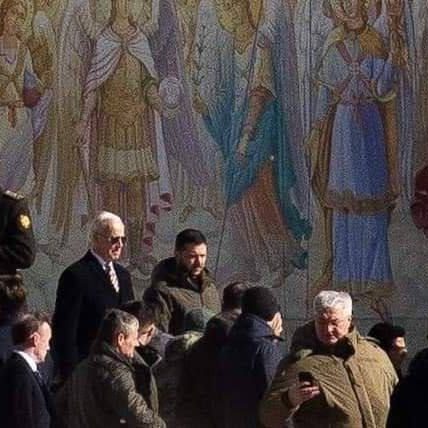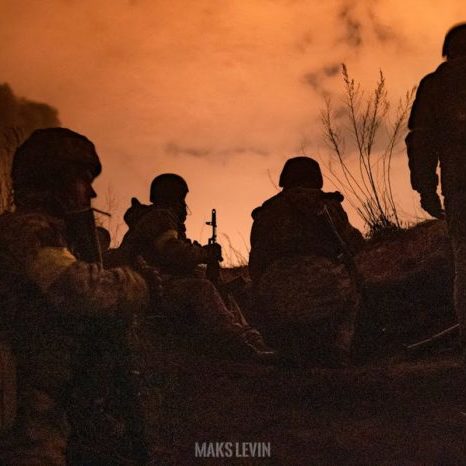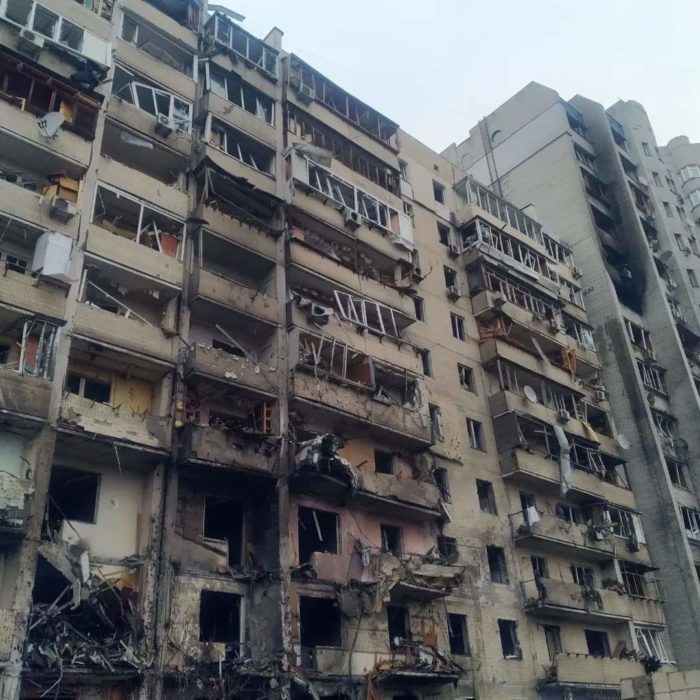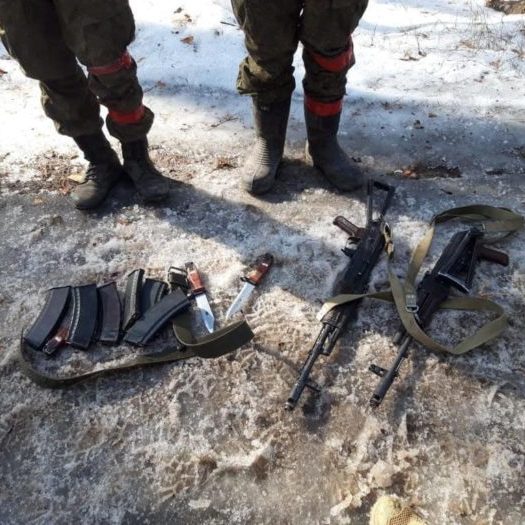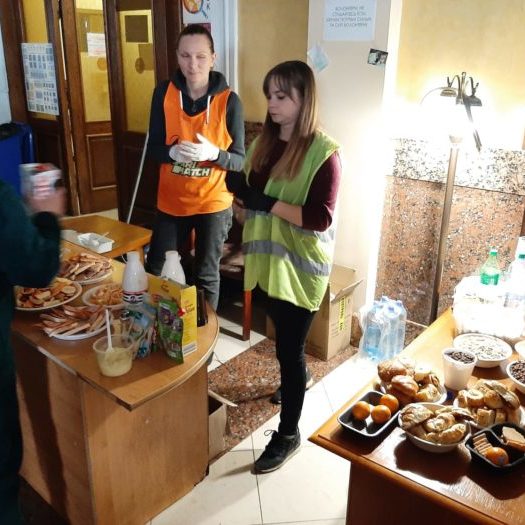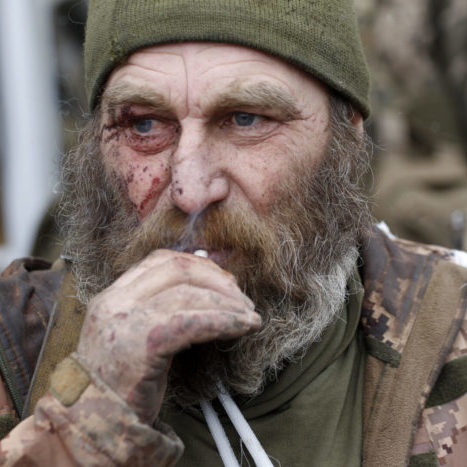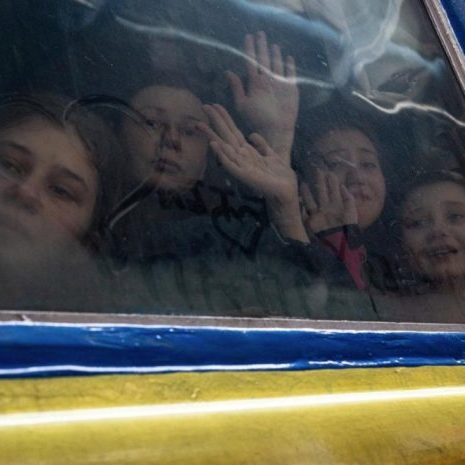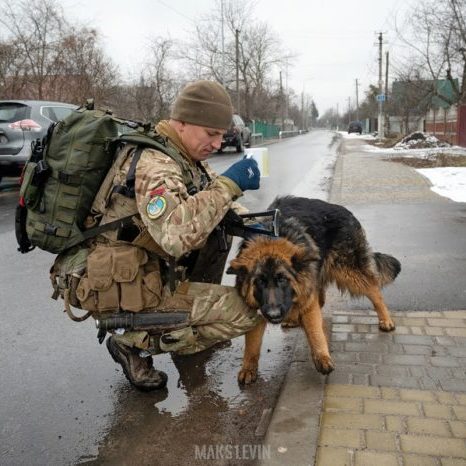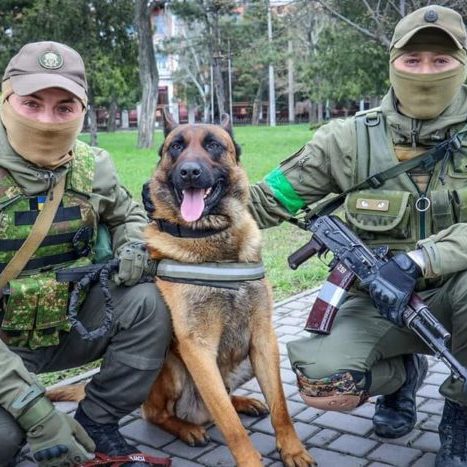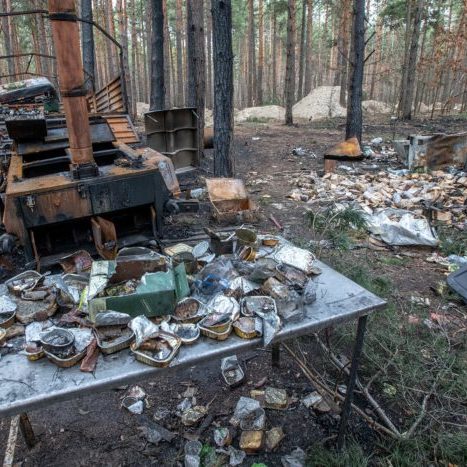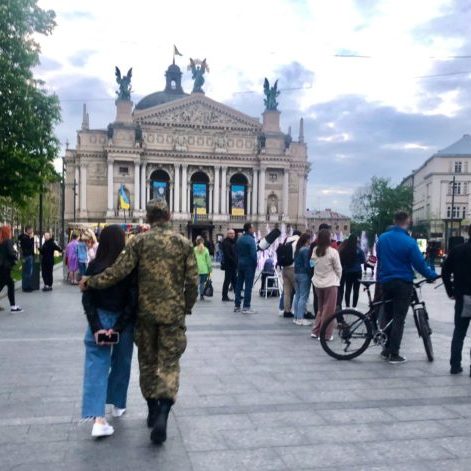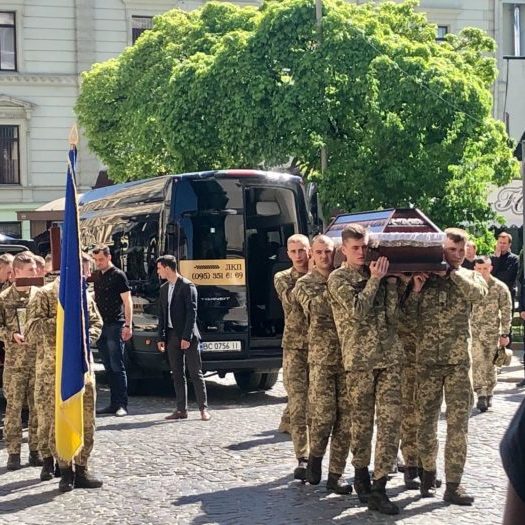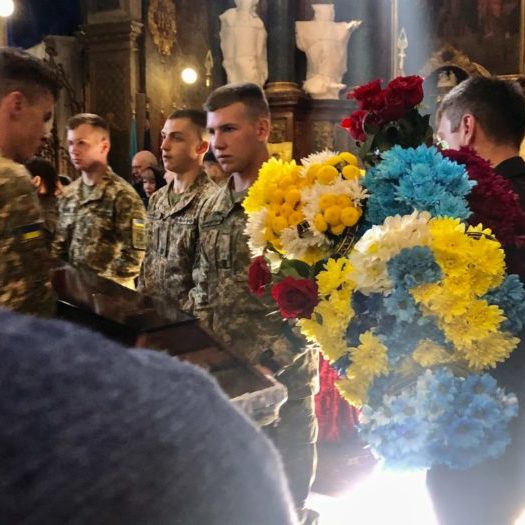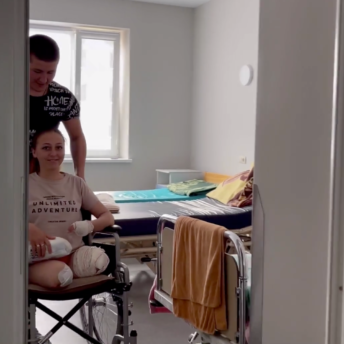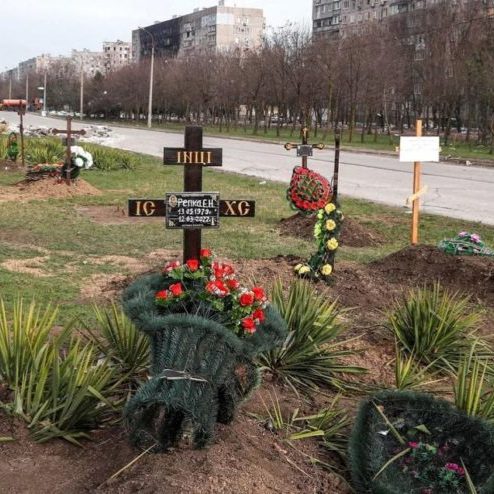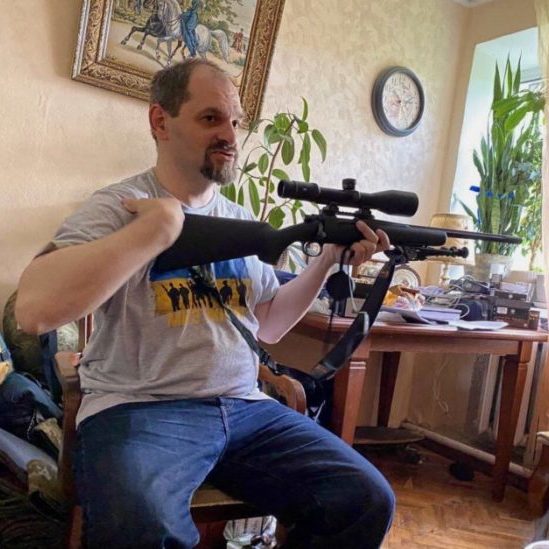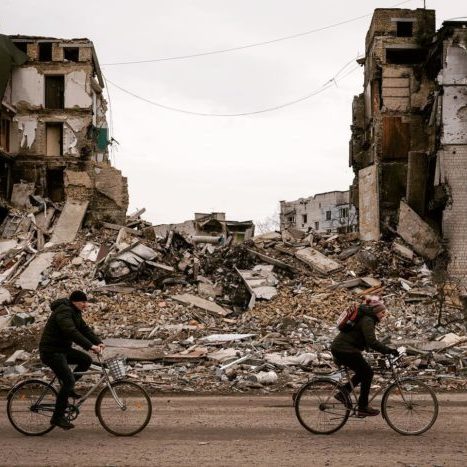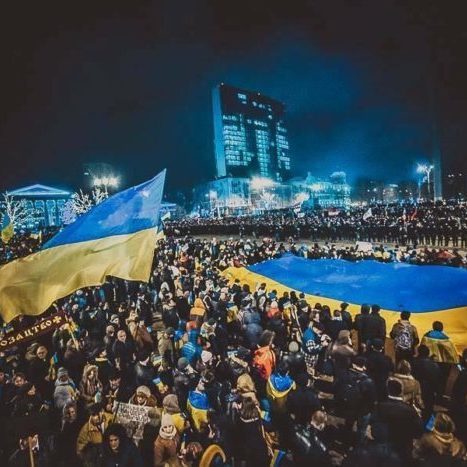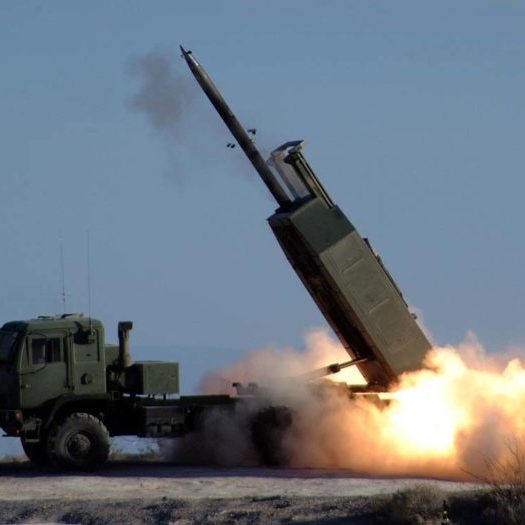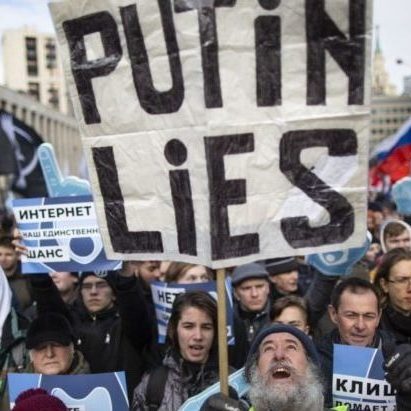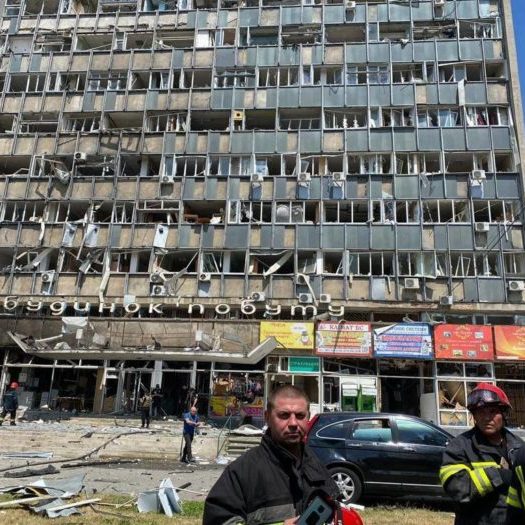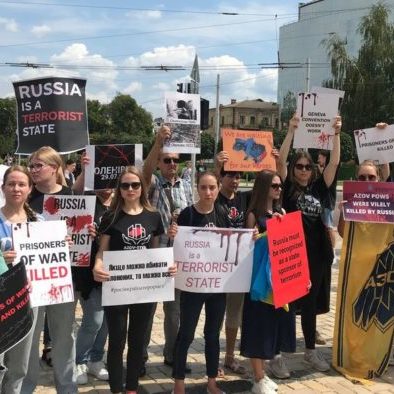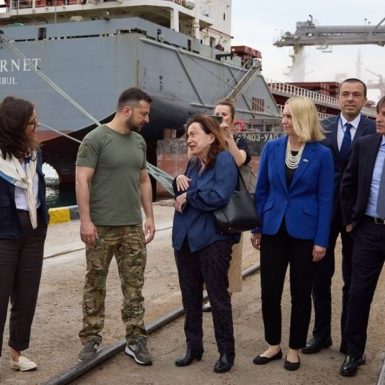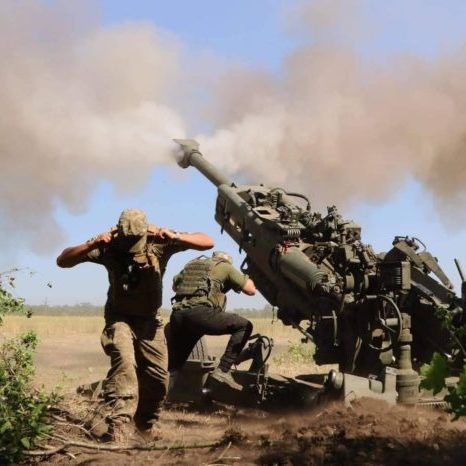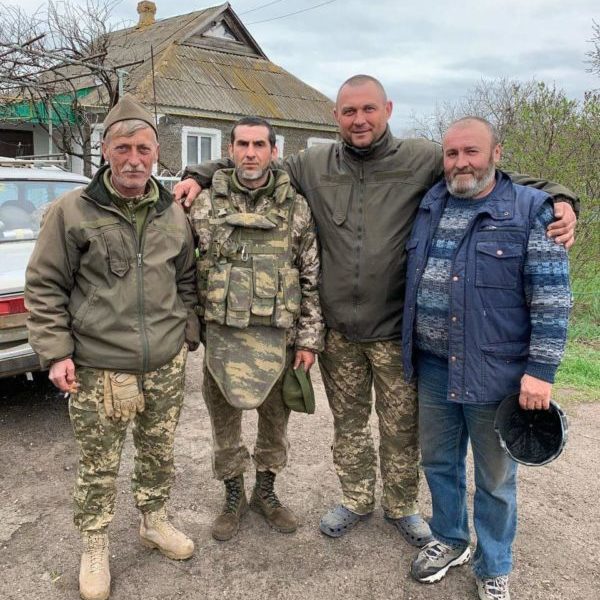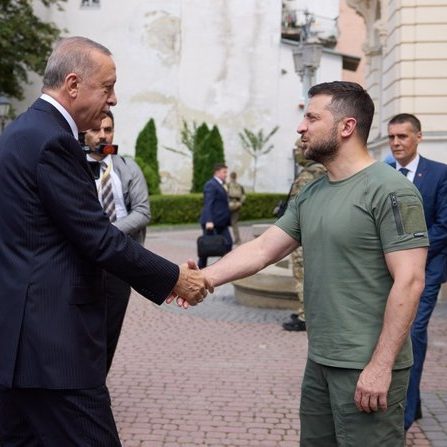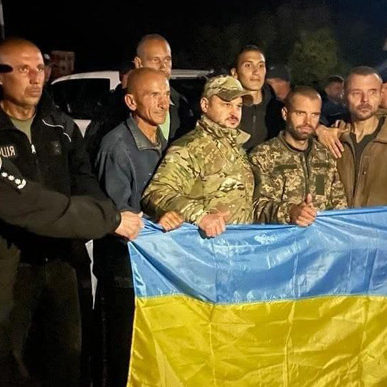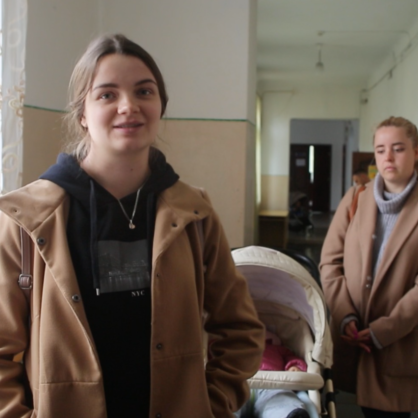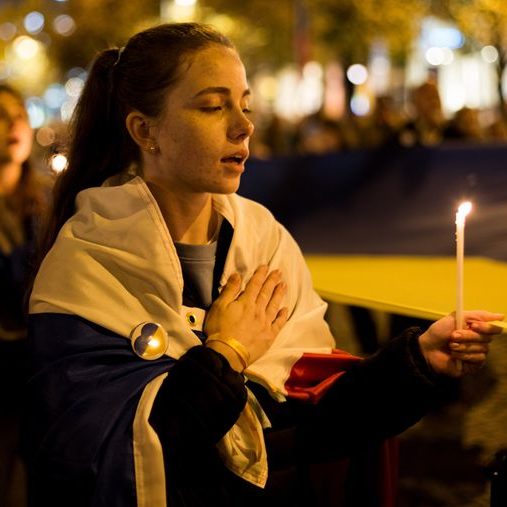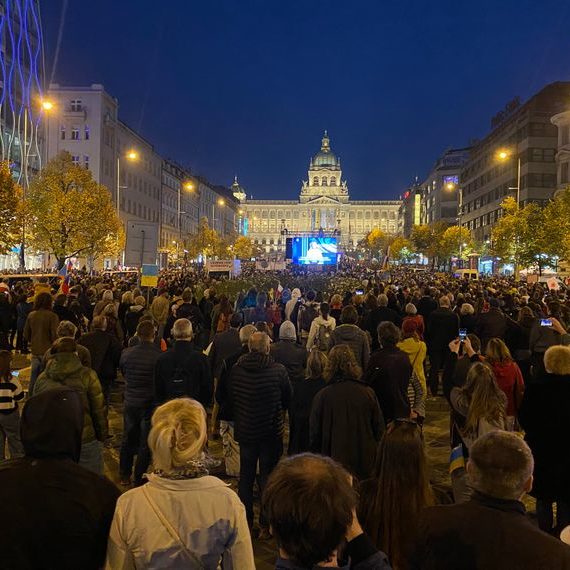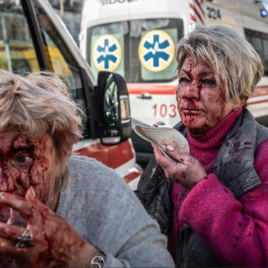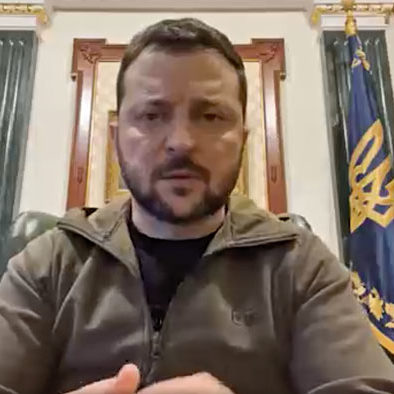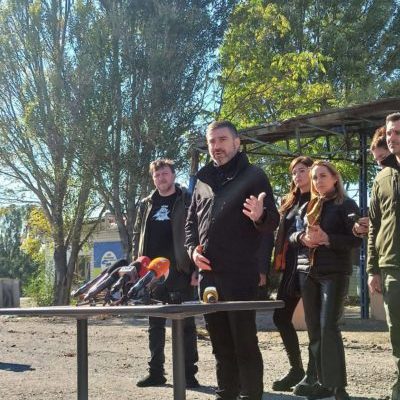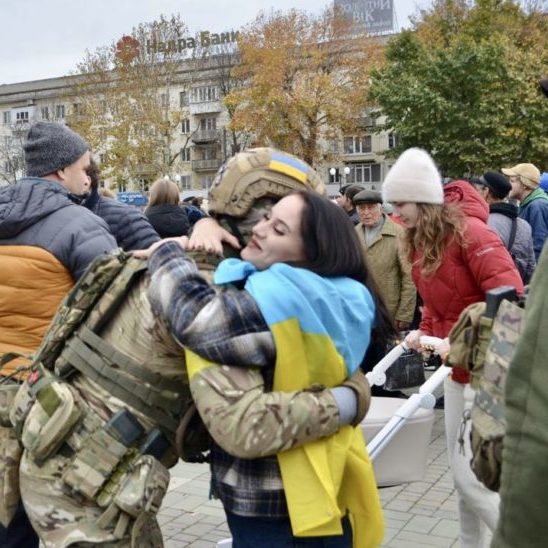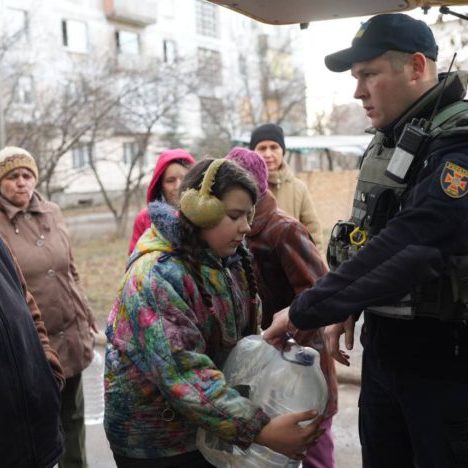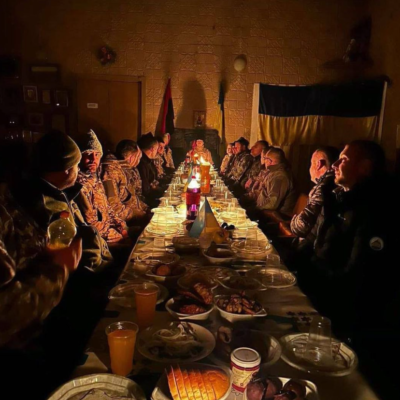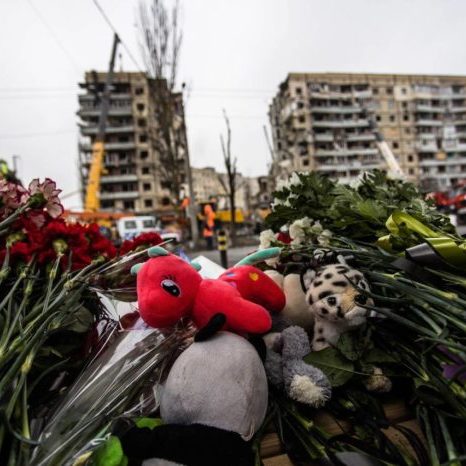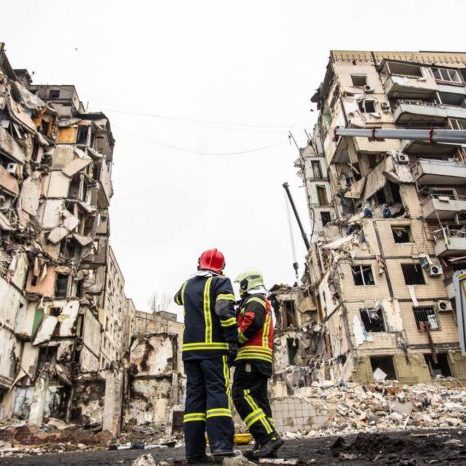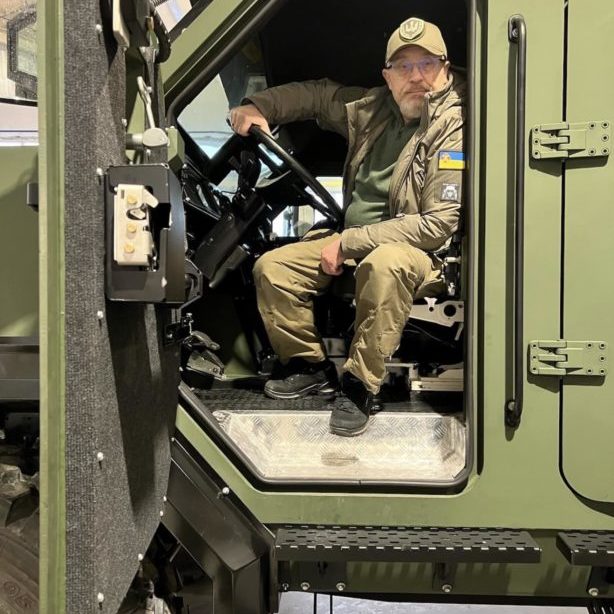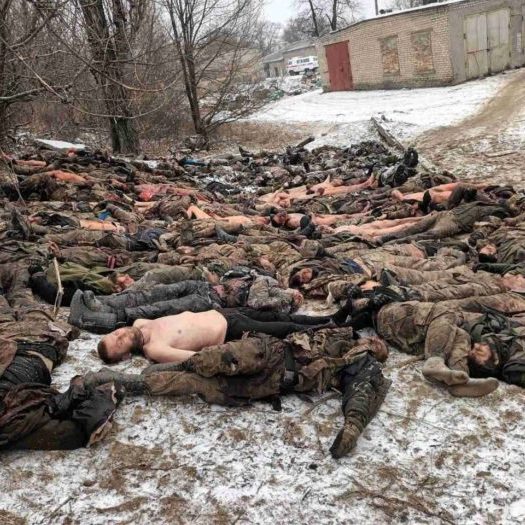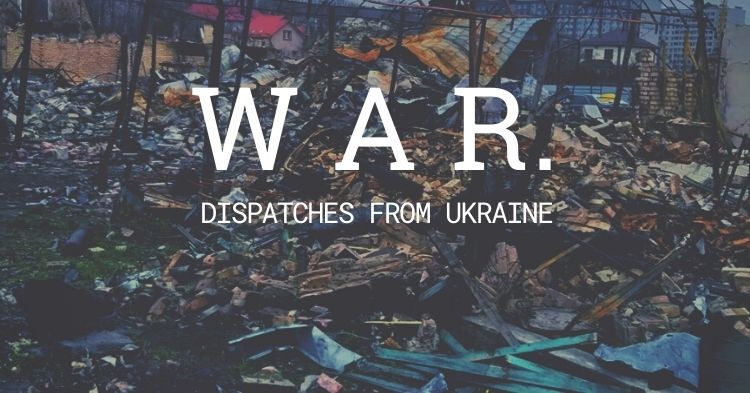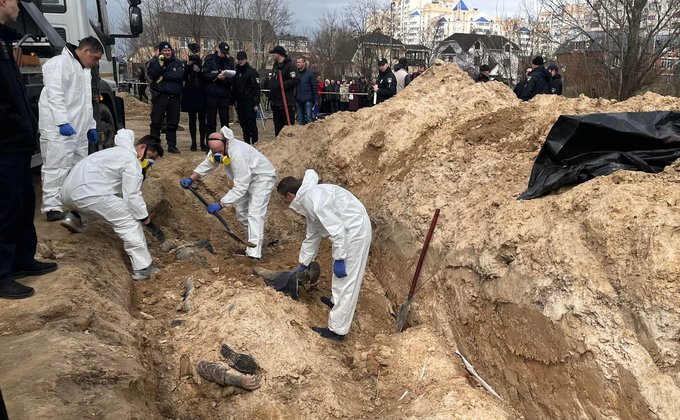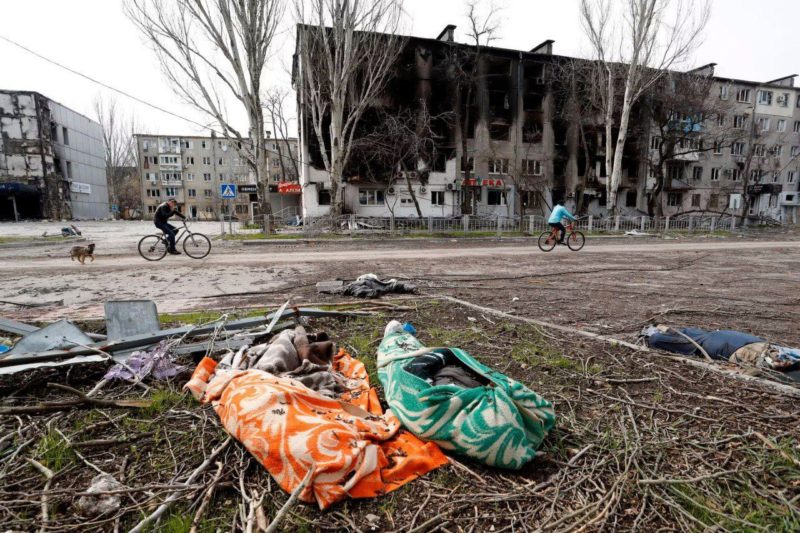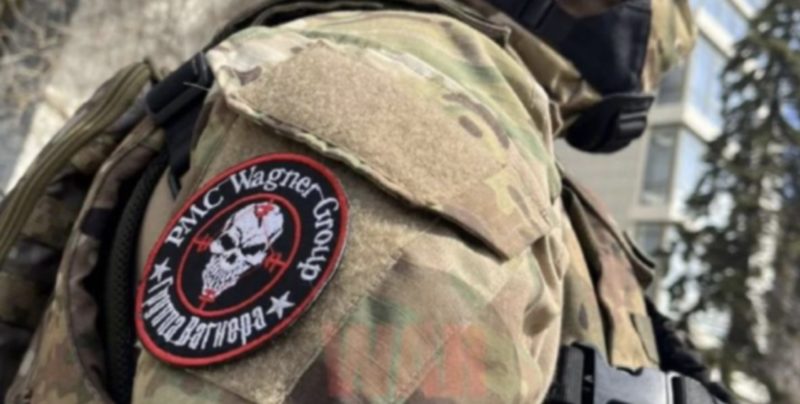February
At 5 am on 24 February Ukraine awakens to the sounds of explosions: Russian missiles are targeting military warehouses, command and control centres, airports and military depots. Russia’s troops attack Ukraine from the north, east and south invading Ukraine’s five administrative oblasts.
While residents load into the cars moving to the west of the country, columns of Ukrainian military vehicles head in the opposite direction “with very tense faces” to meet the aggressor army. At the same time, people of all ages and genders eager to defend their country sign up for the territorial defense forces and receive weapons in all the cities throughout Ukraine.
Thus, territorial defense forces are formed in literally three days, while the Russian army captures the city of Kherson in Ukraine’s south and advances towards the capital. The international media predicts pessimistically that the “second army of the world” will soon encircle Kyiv and capture Ukraine. Simultaneously, the world learns about the first Ukrainian heroes who sacrificed their lives delaying the Russian offensive.
Ukraine and its supporters collectively ask for a No-Fly Zone over Ukraine from NATO.
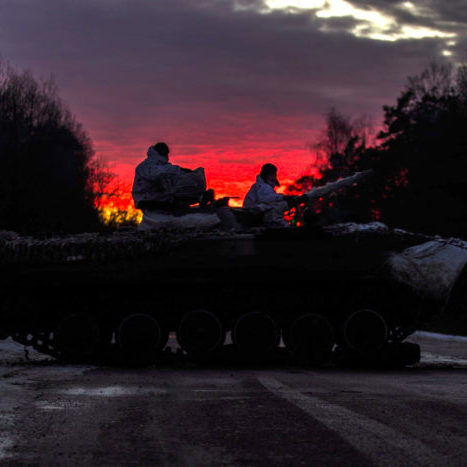
March
Russia’s blitzkrieg strategy fails miserably.
Russia escalates air strikes, bombing hospitals and maternity wards and hitting Ukraine with internationally banned vacuum bombs. Russian soldiers open fire and shoot cars carrying civilian population fleeing the war zone.
Residents of occupied Ukrainian towns engage in peaceful mass protests against Russian invaders. Ukrainians throughout the country in great numbers join grassroots volunteering initiatives to support the army with equipment, vehicles, uniforms, and food; polls show that 80% of Ukrainians participate in the defense of Ukraine in some way.
Ukrainians also want to see the de-occupation of the entire country, including Donbas and Crimea.
The US and Europe impose the first sanctions against Russia, while some major companies leave the aggressor country; in particular, the US slaps full embargo on Russian oil and gas.
International volunteers join the International Legion of Ukraine’s Armed Forces (AFU). Along with the Ukrainian government’s IT army, one of the largest, world-famous hacker groups, Anonymous, cyberattacks Russian governmental institutions.
Independent polls reveal that the majority of Russians support the war against Ukraine and feel “pride, joy, respect, and hope”; journalist polls confirm this. Pro-war Z and V symbols appear and spread across Russia. Thus, hopes for anti-war protests in Russia fade.
Polish, Czech, and Slovenian prime ministers are the first Western leaders to visit Ukraine. The port city of Mariupol is devastated by the Russian besiegement: Russia bombs Mariupol drama theatre with at least 300 civilians inside and a massive sign reading “children.”
The northern city of Chernihiv is encircled from three sides and is under harsh continuous Russian airstrikes. However, with the help and support of volunteers, civilians are able to escape Chernihiv via secret routes, and some humanitarian supplies arrive.
Ukrainians’ pleas to “close the sky” grow louder. “We are not afraid and you must not be either,” the Ukrainian defense minister tells the world.



April
The scope of Russian atrocities in Bucha is revealed as Ukrainian forces recapture large swaths of territory near Kyiv at the end of March. During the Bucha massacre, Russian soldiers murdered 1700 civilians in Bucha district alone.
Russia justifies the genocide of Ukrainians in the programmatic article “What Russia should do to Ukraine.”
The first large counteroffensive continues as Ukrainian forces recapture villages in Chernihiv Oblast, north of Kyiv, and north-eastern Sumy Oblast. Officials and human rights organizations report dozens of cases of rape, torture, looting, and murder of Ukrainians by Russian soldiers.
The situation in Mariupol deteriorates; as of the beginning of April, it is estimated that 5,000 civilians has been killed by the Russian army.
The first Ramstein format meeting brought together defense ministers and senior generals from over 40 countries in Germany to coordinate efforts in arming Ukraine.
NATO rejects pleas to close the skies over Ukraine; Ukraine destroys 130 Russian fighter jets and asks NATO for MiG-29 fighter jets in the face of a much bigger Russian air fleet.
EU remains dependent on Russian oil and gas
. Since 24 February, the EU has paid Russia 20 times more for fossil fuels than for aid to Ukraine. Furthermore, EU’s coal and gas imports from Russia increase.
Activists block the Germany-Poland highway, сalling the EU to suspend trade with Russia and disconnect Russian banks from SWIFT. Many big brands continue to fund Russian attacks on Ukraine, despite consumer outrage and calls for boycotts.
Russia holds about 27,000 Mariupolites in “filtration camps” in Donetsk Oblast. Threatening Kherson farmers, Russian troops steal grain from Ukraine.
Estonian, Latvian, Lithuanian, and Polish Presidents and British Prime Minister Boris Johnson visit Kyiv. Support for Ukraine’s EU accession hits historical all-time high of 91%. The Russian nuclear-capable flagship Moskva sinks after a Ukrainian missile strike.
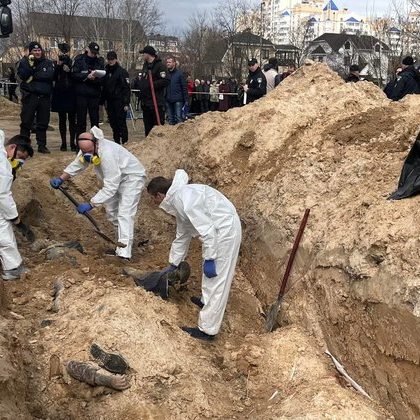
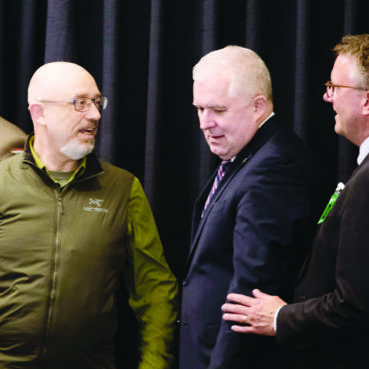

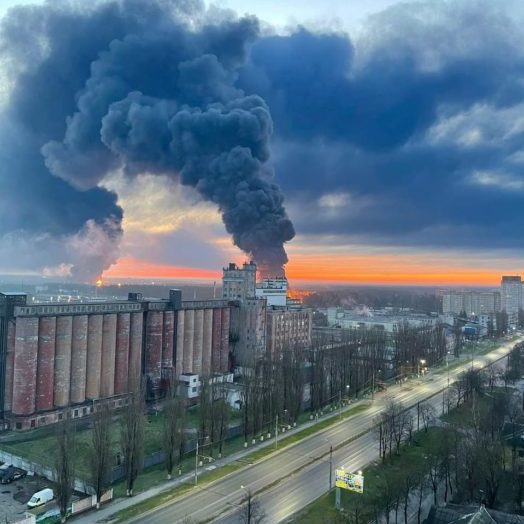

May
Following a 82-day siege, Ukrainian soldiers from the Mariupol garrison left the last remaining Ukrainian fortress in Mariupol, the Azovstal steelworks, per the order of Ukrainian military command. They remain in Russian captivity, having been promised exchange for Russian soldiers.
Russia concentrates its efforts in Donbas, launching a major assault on Sievierodonetsk; Ukrainian forces repel a number of Russian attacks in Donbas and around Kharkiv. Civilians fleeing Mariupol and other occupied areas in Ukraine’s south undergo Russian filtration camps.
Ukraine reiterates its calls for the American MLRS to tip the scales of war in its favor. World leaders call the Russian naval blockade of Ukraine a deliberate attack on the global food supply chain.
Ukrainians report over 400 cases of rape and other forms of sexual violence by Russian invaders. A Russian soldier is sentenced for life in Ukraine’s first Russian war crimes case.
Following Lenin, imperial Pushkin monuments disappear from Ukrainian streets as decolonization unfolds in Ukraine. Ukrainians reject any concessions to Russia and blame Russian leaders and citizens for the war.
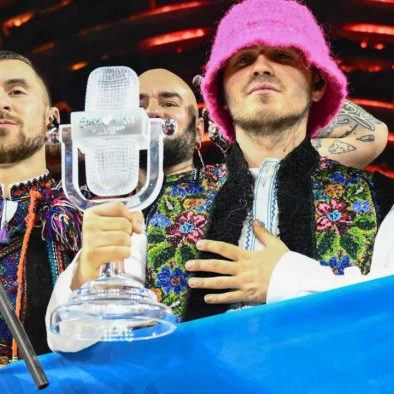
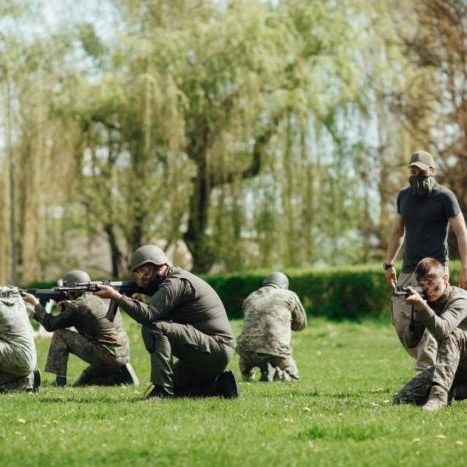
June
Ukrainian forces retreat from Sievierodonetsk in the east after months-long battles for the city, where Ukraine suffered one of the heaviest losses in 2022r, losing 200–300 soldiers per day during the tensest days of fighting.
The leaders of France, Germany, Italy, and Romania visit Kyiv to support Ukraine’s candidacy for EU membership. Later in June, EU grants Ukraine candidate status and provides recommendations to meet EU’s membership criteria.
Russian troops methodically destroy fuel storage facilities in Ukraine’s east. On its side, Ukraine starts hitting ammunition depots deep in Russia’s rear.
The EU has imposed a partial oil embargo as part of its 6th sanctions package. Russia strikes a Kremenchuk shopping mall with 1,000 civilians inside and distributes passports in occupied Ukrainian cities.
So far, Ukraine has documented over 11,600 war crimes commited by Russian forces. Kherson Oblast’s growing partisan movement bombs collaborators. Polls show, Ukrainians want to join the EU and NATO, love Duda and Johnson. According to a leading Ukrainian sociologist recent opinion polls indicate that three months of Russian invasion have changed Ukrainians more than the previous 30 years.
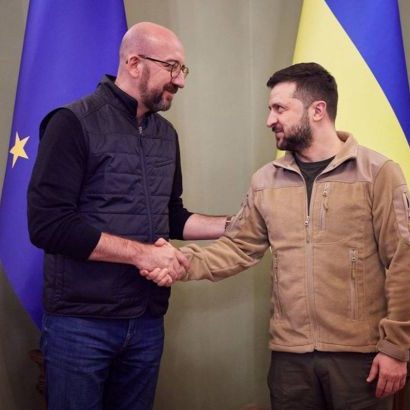
July
On 1 July, the battle of Zmiinyi Island (Zmiinyi (Snake) Island) in the Black Sea culminates in Ukraine’s victory. Russia retaliates with three cruise missile attacks on Serhiivka, a small resort town in Odesa Oblast. It kills 21 and injures 38 civilians. Following another brutal Russian missile strike in Vinnytsia that killed two dozen people, Ukraine calls to designate Russia a terrorist state.
The explosion in Olenivka, occupied Donetsk Oblast, killed 53 Ukrainian POWs in a prison. The majority of them were Azovstal defenders. Ukraine’s General Staff has said Russia is behind the explosion to conceal the signs of torture of Ukrainian POWs.
Historians and social scientists label Russian politics as fascist.
Western allies deliver the first HIMARS MLRS and Howitzers to Ukraine. The Ukrainian Army employs them effectively, destroying Russian artillery depots and storage bases in particular. The Ukrainian Army withdraws from Lysychansk.
A breakthrough happens at Ukrainian grain negotiations in Istanbul: 16 vessels sail to be loaded with Ukrainian grain. Zelenskyy orders deoccupation of Ukraine’s south.

August
Donetsk Oblast remains the hot spot in Ukraine. In one week, 22 Russian ammunition depots are destroyed; some of them detonate in Crimea. Additionally, more than a dozen of explosions
destroy the Russia-occupied Crimea airfield.
Ukraine’s forces liberate some villages from Russian occupation in Kherson Oblast. Russia continues to bomb Ukrainian cities; Kharkiv, Zaporizhzhia, and Mykolayiv are shelled en masse, including the area around the Zaporizhzhia nuclear power plant (ZNPP).
Wagner PMC begins recruiting Russian criminals and convicts for the war in Ukraine, which will lately take a decisive part in the prolonging of fighting in the Bakhmut area.
Latvia designates Russia a state sponsor of terrorism. According to insider information of the head of Mariupol TV and a volunteer, the city’s morgues have documented the deaths 87,000 people during the Russian siege of Mariupol.
On 24 August 2022, Ukrainian Independence Day, Biden announces a $3 billion military aid package. Zelenskyy asserts that negotiations are only possible when Russian troops leave Ukraine. More than 90% of Ukrainians trust the armed forces and veterans of wars against Russia, polls show.
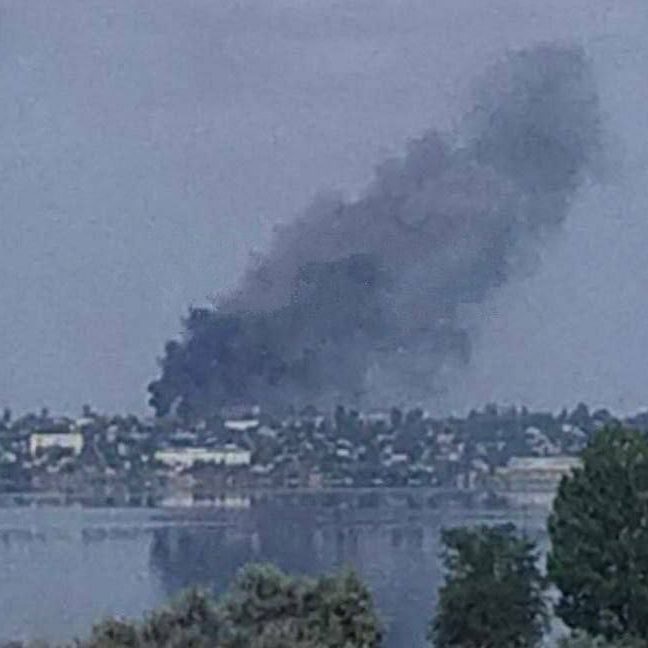
September
Ukraine launches a blitzkrieg counteroffensive in Kharkiv Oblast, advancing 75 km in four days and retaking the major cities of Balakliya, Izium, and Kupiansk, among dozens of others. After six months of Russian occupation, Kharkiv Oblast returns to life in Ukraine.
The majority of more than 500 Ukrainians whose bodies were exhumed from mass graves in the deoccupied Izium exhibited signs of violent death; bodies of Ukrainian soldiers were found with their hands tied. Putin announces “partial mobilization” in Russia, promptring a large number of Russians to flee the country.
Moreover, Putin escalates his nuclear blackmail again and conducts staged sham referenda in occupied areas of Ukraine. Ukraine calls for the establishment of a Special Tribunal to prosecute the Russian military and leadership for crimes committed in Ukraine. In a new treaty for security guarantees, Ukraine retains NATO aspirations.
215 Ukrainian POWs are freed from Russian captivity, including Azovstal defenders who are sent to rehabilitation due to inhumane conditions in captivity. At the same time, the Russian patriarch tells invading army that being killed in Ukraine washes away all sins.
Polls suggest that Russia’s war is hastening the Ukrainization of Ukraine after decades of Russian imperial influence.
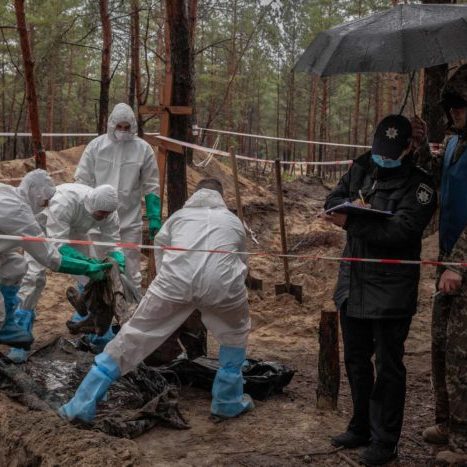
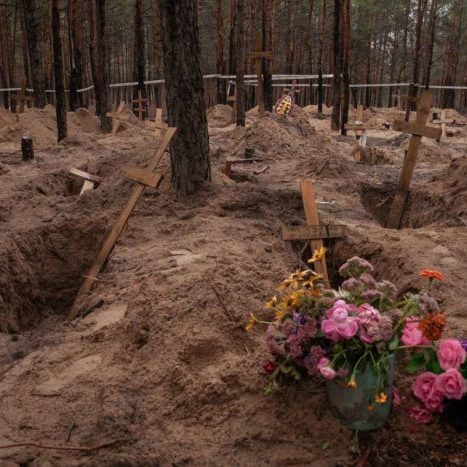
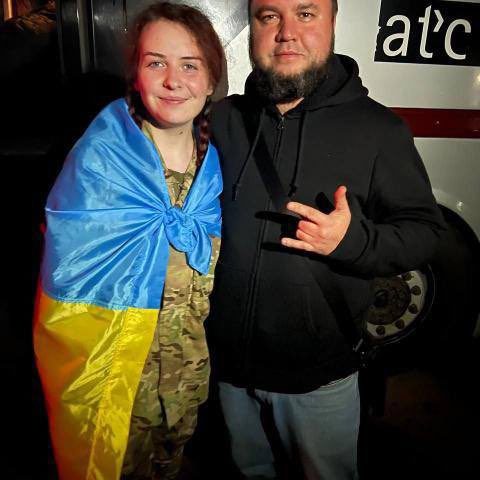
October
Crimea’s Kerch bridge partially collapses after a powerful explosion.
Russia is increasingly using Iranian Shakhed drones to strike Kyiv and other Ukrainian cities. It also targets Ukraine’s energy infrastructure by launching massive missile attacks. Day after day, Ukraine’s forces are gradually improving their ability to shoot down Iranian drones more effectively.
Ukraine slowly advances in Kherson Oblast, liberating seven villages where Russians left death and destruction. Following the September counteroffensive, Russian torture chambers were discovered in Kharkiv Oblast.
The oil price cap in the EU’s 8th Russia sanctions package, falls short of Kyiv’s expectations. In Belarus, Lukashenka orders covert mobilization. “The brave people of Ukraine” win the EU Parliament’s 2022 Sakharov prize.

November
Euphoria in Kherson after Ukrainian troops liberated the city, following the doccupation of more than two dozen of Kherson Oblast settlements. Retreating from Kherson, it looted precious paintings collection of its museum.
Ukraine suffers from multiple waves of massive Russian missile strikes on energy infrastructure, as well as power blackouts
. Russia forms defensive lines in southern Ukraine, including Crimea, to repel Ukrainian counteroffensive. Fierce fighting continues in Donbas.
Zelenskyy lays out Ukraine’s peace formula: Russia has to withdraw from Ukraine, return POWs and deportees, and pay reparations.
The NATO Parliamentary Assembly unanimously recognizes Russia as a terrorist state, while Romania, Moldova, and Ireland recognize Stalin’s Holodomor famine as genocide against Ukrainians.
Russian shelling damaged the infrastructure of the Zaporizhzhia nuclear power plant. Schoolchildren in Russia-occupied Ukraine are taught to hate their homeland. After retreating, Russia shells liberated Kherson, forcing locals to flee. According to Ukrainian officials, 30% of Ukraine’s territory is mined. 18 countries investigate Russian war crimes.
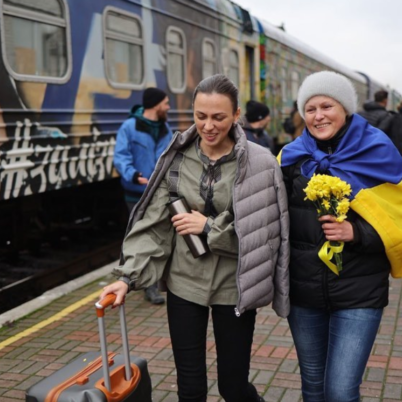

December
Russian Wagner PMC, primarily comprised of prisoners, and the Russian regular army continue offensive operations on Bakhmut, Donetsk Oblast, described as “hell on Earth;” the city is practically destroyed. Russia suffers heavy losses in Bakhmut, as Russian troop losses in Ukraine surpass 100,000.
Massive missile strikes with about 60–70 missiles launched at once are becoming more common, with the majority of missiles typically being intercepted by Ukrainian forces. However, some missiles are able to reach Ukraine’s power facilities and civil infrastructure.
The Russian Engels-2 strategic bomber air base, located about 600 km from the Ukrainian border, is attacked twice during a month. During the month of December Ukrainian army liberated approximately 70 square km of Ukrainian territory.
European Parliament recognizes Holodomor as genocide against Ukrainians, while the 9th package of EU sanctions targets about 200 Russian entities.
Zelenskyy addressed the US Congress on his first known trip outside Ukraine since Russia’s full-scale invasion in February. The Ukrainian Center for Civil Liberties received the Nobel Peace Prize for 2022.
Ukrainian embassies and consulates throughout Europe receive threatening letters with blood and animal eyes. Russia’s war causes environmental calamity for Ukraine Zelenskyy says.
Ukraine’s President and the spirit of Ukraine are named TIME’s Person of the Year for 2022. Russia rejects Zelenskyy’s proposal to withdraw its troops from Ukraine.

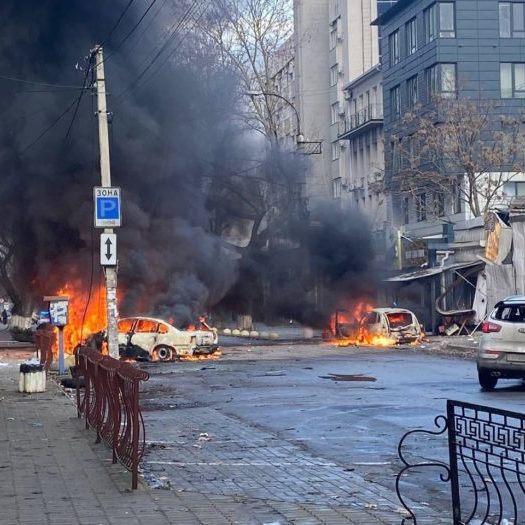
January
On New Year’s Eve, Russia targets Ukraine’s residential areas. In seven days, it declares an Orthodox “Christmas truce” but shells Ukraine several hours after.
Russia captures the town of Soledar, located north of Bakhmut, where fierce and incessant fighting continues. Russia also suffers heavy losses in Vuhledar later during the month.
After lengthy hesitance on the part of Germany, the primary Leopard 2 tanks manufacturer, Ukraine is promised to receive 80 battle tanks from Europe: 12 countries (Poland, Germany, Portugal, Spain, Norway, Finland, the Netherlands, Canada, and others) have expressed willingness to transfer Leopard 2 tanks. Moreover, the US promises Abrams tanks.
Ukraine finally commences domestic ammunition production and organizes manufacturing its indigenous 155mm self-propelled howitzer, Bohdana.
45 persons, including six children, are killed in a horrifying Russian missile attack on a high-rise building in Dnipro.
To punish Russian crimes in Ukraine, the European Parliament pushes for special tribunal in response to Ukraine’s calls; the Council of Europe prepares the establishment of the Tribunal in the subsequent steps.
Ukrainian liturgy returns to the historical Kyiv monastery after a 300-year of ban. Polling reveals that a record-high 86% of Ukrainians support the country’s accession to NATO.
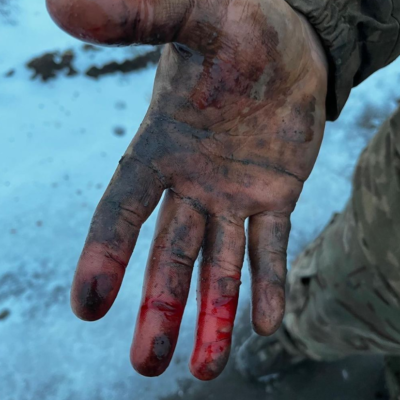

February
Russia sustains its highest rate of casualties since the outbreak of the full-scale war, with an average of 824 losses per day. In particular, according to the White House, Wagner Group has suffered over 30,000 casualties in Ukraine.
Russia continues to target Ukraine’s energy infrastructure with missile strikes as Ukraine extends martial law and mobilization till mid-May 2023.
The President of the EU Commission Ursula von der Leyen and half of European commissioners arrive in Kyiv for the Ukraine-EU summit. US President Biden visits Kyiv before the first anniversary of Russia’s unprovoked full-scale invasion of Ukraine.
Russia suspends participation in nuclear arms treaty. 89% of Ukrainians want to continue fighting even after Russian nuclear strike. According to a US-backed report, Russia has held at least 6,000 Ukrainian children for "re-education." Ukraine is pushing for F-16 fighter jets. In this regard, the US says it would welcome other countries’ decisions to provide fighter aircraft to Ukraine. Ukraine’s Defense Minister “satisfied” with the Ramstein meeting, where military aid to Ukraine was discussed. Donetsk Oblast is continuing to see fierce fighting.

